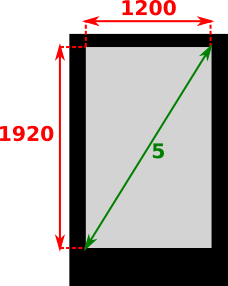Smartphone Screen
Can you find the length and width of the screen of this smartphone in inches?
Problem
A smartphone's display is given as the diagonal distance between the vertices. A certain smartphone has a 5 inch display and a resolution of 1920 pixels (length) x 1200 pixels (width).
What are the length and width of the display, in inches? Leave your answer in the form $\dfrac{a}{\sqrt b}$, where $a$, $b$ are integers.
This problem is adapted from the World Mathematics Championships
Student Solutions
It is helpful to begin with a diagram of the smartphone. The red lengths are given in pixels, and the green length is given in inches.

Using a unit conversion between inches and pixels
Pythagoras' theorem can be used to find the the display of the smartphone in pixels.
$$\begin{align}&1920^2+1200^2=c^2\\\Rightarrow&5126400=c^2\\\Rightarrow& c=\sqrt{5216400}=240\sqrt{89}\approx2264.2\end{align}$$
$240\sqrt{89}$ can be obtained without a calculator using factorisation:
$$\begin{align} &1920^2+1200^2=c^2\\
\Rightarrow &(20\times96)^2+(20\times60)^2=c^2\\
\Rightarrow &20^2\times96^2+20^2\times60^2=c^2\\
\Rightarrow &20^2\times\left(96^2+60^2\right)=c^2\\
\Rightarrow &20^2\times4^2\times\left(24^2+15^2\right)=c^2\\
\Rightarrow &20^2\times4^2\times3^2\times\left(8^2+5^2\right)=c^2\\
\Rightarrow &(20\times4\times3)^2\times(64+25)=c^2\\
\Rightarrow &240^2\times89=c^2\end{align}$$
So $c=240\sqrt{89}$ pixels, which is $5$ inches, and so each pixel must be $\dfrac{5}{240\sqrt{89}}$ inches.
So $1920$ pixels must be $\dfrac{1920\times5}{240\sqrt{89}}=\dfrac{40}{\sqrt{89}}$ inches,
and $1200$ pixels must be $\dfrac{1920\times5}{240\sqrt{89}}=\dfrac{25}{\sqrt{89}}$ inches.
Using the ratio between the sides
Calling the length and width in inches $p$ and $q$, we know that $\dfrac{q}{p}=\dfrac{1200}{1920}$, which simplifies to $\dfrac{5}{8}$. So if $\dfrac{q}{p}=\dfrac{5}{8}$, then $q=\dfrac{5}{8}p$.
By Pythagoras' theorem, $p^2+q^2=5^2$, so $$\begin{align}&p^2+\left(\frac{5}{8}p\right)^2=5^2\\
\Rightarrow&p^2+\frac{25}{64}p^2=5^2\\
\Rightarrow&\frac{64p^2+25p^2}{64}=25\\
\Rightarrow&\frac{89p^2}{64}=25\\
\Rightarrow&89p^2=25\times64\\
\Rightarrow&p^2=\dfrac{5^2\times8^2}{89}\\
\Rightarrow&p=\sqrt{\dfrac{5^2\times8^2}{89}}=\dfrac{5\times8}{\sqrt{89}}=\dfrac{40}{\sqrt{89}}\end{align}$$
And $q=\dfrac{5}{8}p=\dfrac{5}{8}\dfrac{40}{\sqrt{89}}=\dfrac{25}{\sqrt{89}}$
Image

Using a unit conversion between inches and pixels
Pythagoras' theorem can be used to find the the display of the smartphone in pixels.
$$\begin{align}&1920^2+1200^2=c^2\\\Rightarrow&5126400=c^2\\\Rightarrow& c=\sqrt{5216400}=240\sqrt{89}\approx2264.2\end{align}$$
$240\sqrt{89}$ can be obtained without a calculator using factorisation:
$$\begin{align} &1920^2+1200^2=c^2\\
\Rightarrow &(20\times96)^2+(20\times60)^2=c^2\\
\Rightarrow &20^2\times96^2+20^2\times60^2=c^2\\
\Rightarrow &20^2\times\left(96^2+60^2\right)=c^2\\
\Rightarrow &20^2\times4^2\times\left(24^2+15^2\right)=c^2\\
\Rightarrow &20^2\times4^2\times3^2\times\left(8^2+5^2\right)=c^2\\
\Rightarrow &(20\times4\times3)^2\times(64+25)=c^2\\
\Rightarrow &240^2\times89=c^2\end{align}$$
So $c=240\sqrt{89}$ pixels, which is $5$ inches, and so each pixel must be $\dfrac{5}{240\sqrt{89}}$ inches.
So $1920$ pixels must be $\dfrac{1920\times5}{240\sqrt{89}}=\dfrac{40}{\sqrt{89}}$ inches,
and $1200$ pixels must be $\dfrac{1920\times5}{240\sqrt{89}}=\dfrac{25}{\sqrt{89}}$ inches.
Using the ratio between the sides
Calling the length and width in inches $p$ and $q$, we know that $\dfrac{q}{p}=\dfrac{1200}{1920}$, which simplifies to $\dfrac{5}{8}$. So if $\dfrac{q}{p}=\dfrac{5}{8}$, then $q=\dfrac{5}{8}p$.
By Pythagoras' theorem, $p^2+q^2=5^2$, so $$\begin{align}&p^2+\left(\frac{5}{8}p\right)^2=5^2\\
\Rightarrow&p^2+\frac{25}{64}p^2=5^2\\
\Rightarrow&\frac{64p^2+25p^2}{64}=25\\
\Rightarrow&\frac{89p^2}{64}=25\\
\Rightarrow&89p^2=25\times64\\
\Rightarrow&p^2=\dfrac{5^2\times8^2}{89}\\
\Rightarrow&p=\sqrt{\dfrac{5^2\times8^2}{89}}=\dfrac{5\times8}{\sqrt{89}}=\dfrac{40}{\sqrt{89}}\end{align}$$
And $q=\dfrac{5}{8}p=\dfrac{5}{8}\dfrac{40}{\sqrt{89}}=\dfrac{25}{\sqrt{89}}$
